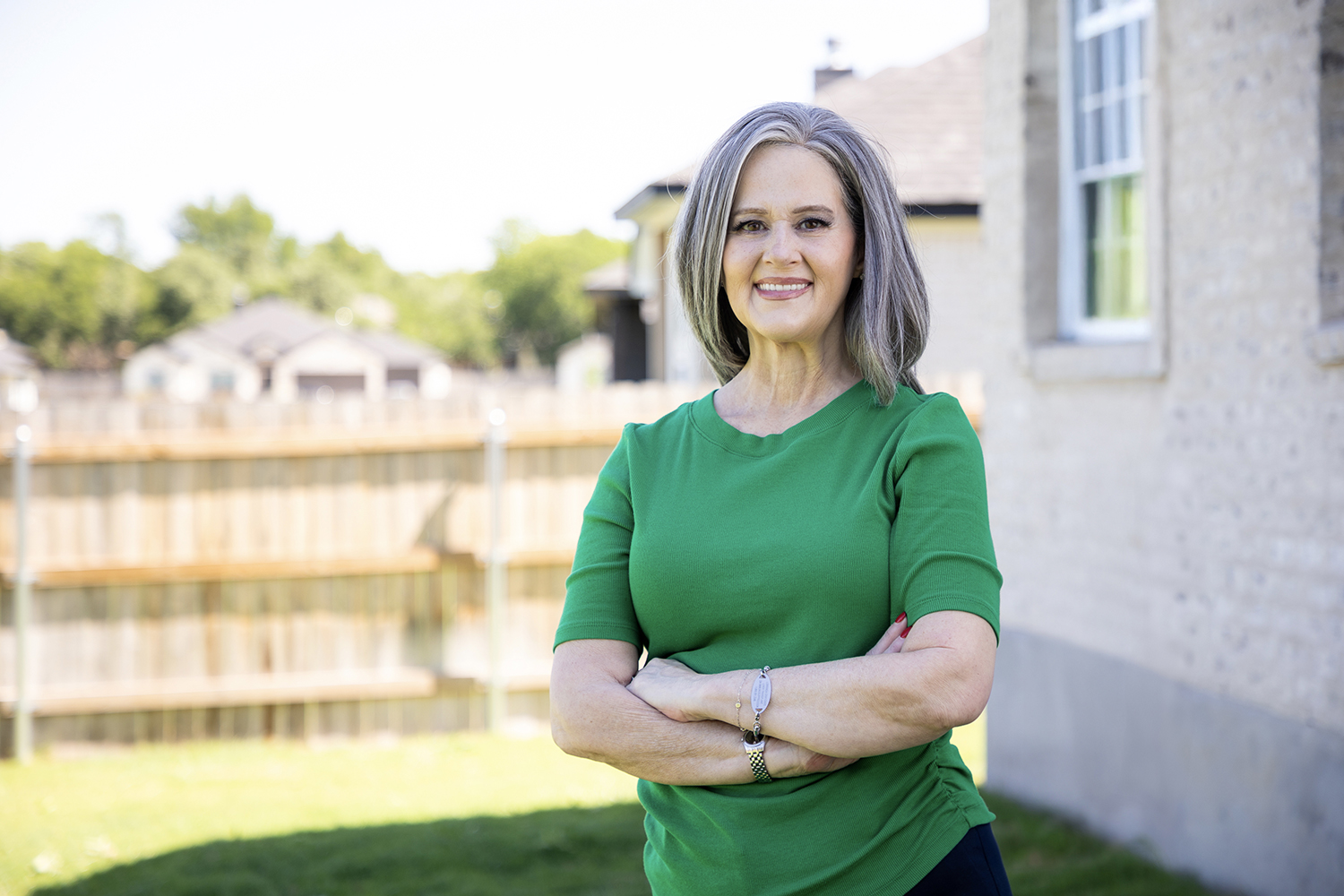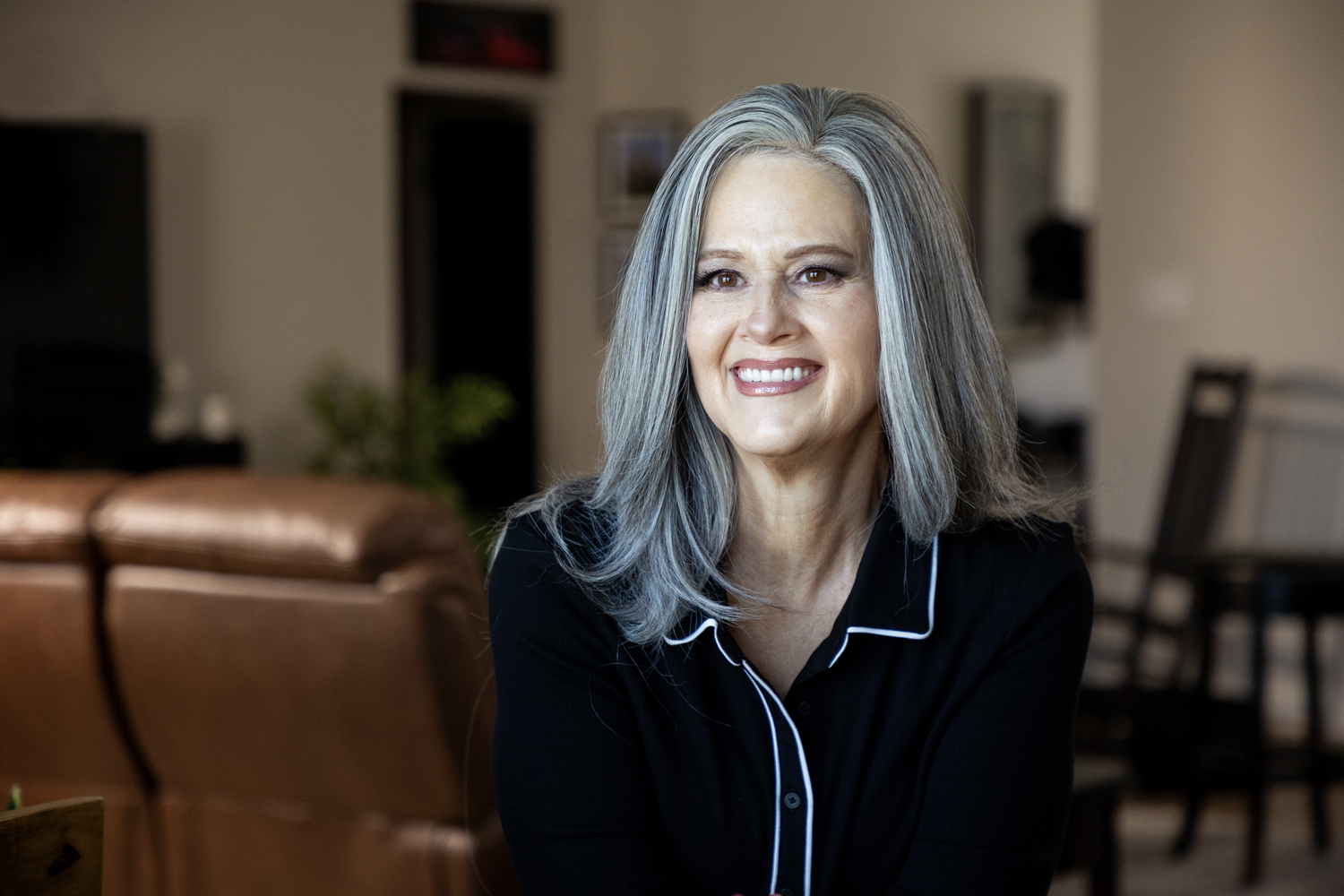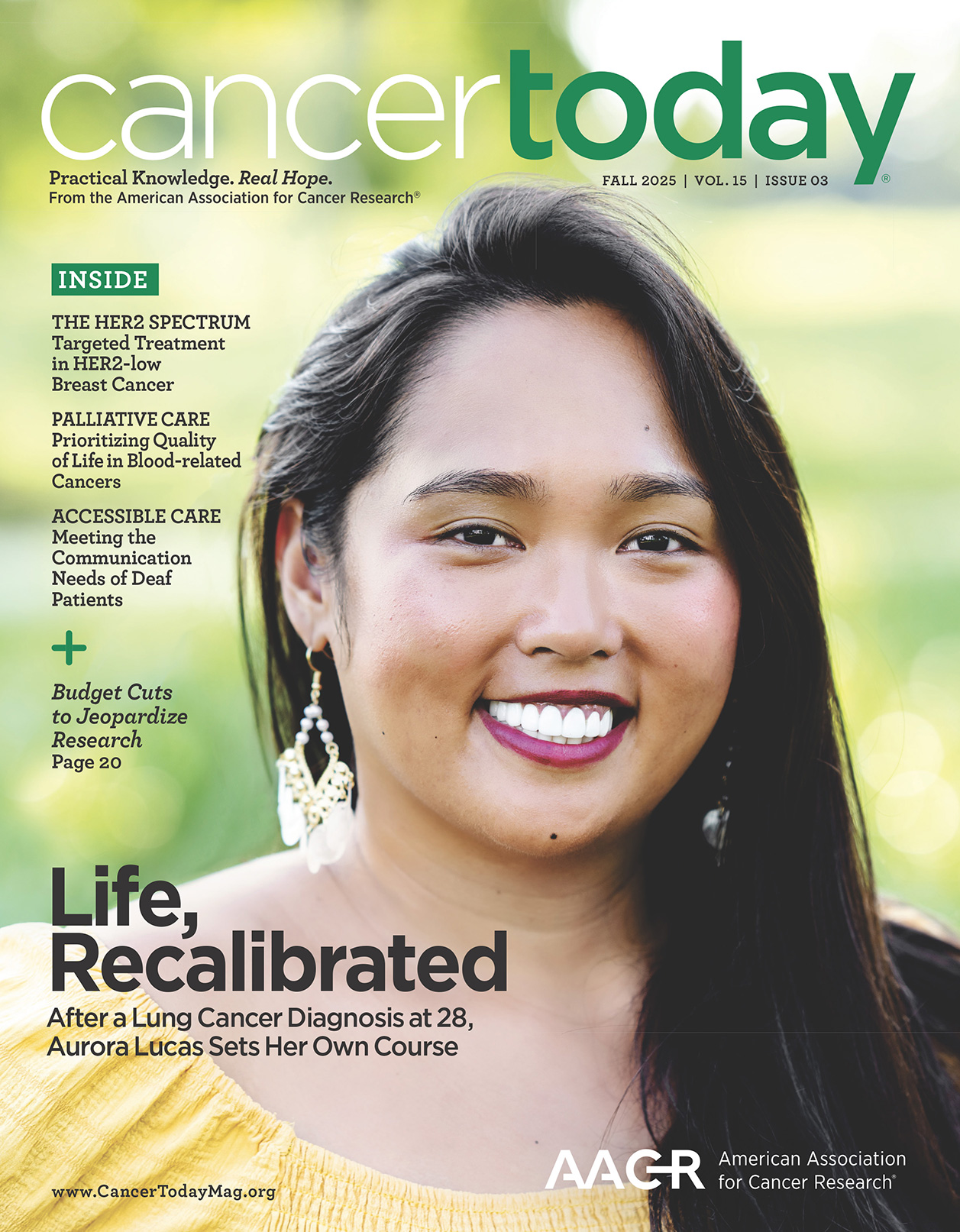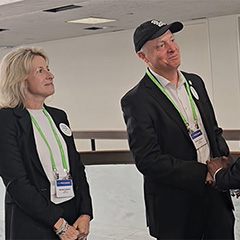IMPORTANT DATES remain burned in Lorrinda Gray-Davis’ memory: April 7, 2017, her first day of sobriety; Feb. 20, 2018, the day she was added to the waiting list for a new liver; Aug. 8, 2018, the day she had a life-saving liver transplant. Since then, Gray-Davis has devoted herself to weaving a network of mutual support and advocacy for fellow transplant candidates and recipients.
Soon after receiving her new liver, Gray-Davis joined the board of directors of Transplant Recipients International Organization (TRIO). The U.S.-based nonprofit provides advocacy, awareness, support and education for transplant candidates and recipients and their families, as well as the families of organ and tissue donors around the world. Today, she is president of TRIO. She is also a member of the patient advisory group for the American Association for the Study of Liver Diseases, vice chair of the patient affairs committee for the United Network for Organ Sharing (UNOS), and a founder and co-lead of Honor the Gift, a coalition of 16 transplant patient advocacy organizations and allies that fight for greater access to post-transplant care.
“Every day is a gift,” says the 57-year-old, who lives in Temple, Texas. “I want to use my voice in a good way.”
A Devastating Diagnosis
Gray-Davis was 49 when she was diagnosed with inoperable hepatocellular carcinoma (HCC), the most common liver cancer type, in July 2017. Looking back, the signs she and her doctors missed are now painfully clear.
She was in her late 30s, commuting weekly from Phoenix to Las Vegas as a director of diversity in the construction industry, when routine bloodwork indicated she had high liver enzymes. Her doctors seemed unconcerned, and Gray-Davis was too busy to give it much thought. She was a single mom going through a divorce. She was also traveling nationwide to recruit minority- and woman-owned businesses for two multibillion-dollar construction projects on the Las Vegas strip.
Later, she experienced fatigue, digestive issues and full-body episodes of psoriasis and other rashes, all signs of liver dysfunction. “I wasn’t really paying attention because I wouldn’t associate anything with my liver,” says Gray-Davis. “Nor did my doctor.” In 2014, when she was diagnosed with fatty liver disease, also known as metabolic-associated steatohepatitis (MASH) or non-alcoholic steatosis (NASH), her doctors seemed confident that with a healthier diet, more exercise and less alcohol, her liver would bounce back. “Watch what you do; it’s not a big deal,” was the message she got, says Gray-Davis. “But it really is a big deal.”

Lorrinda Gray-Davis established online support groups for people going through liver transplants after feeling isolated when she went through the transplant process. Photo by Eric Guel
The human liver is a powerhouse filter responsible for cleaning and detoxifying the blood and for metabolizing nutrients. And while the organ is one of our most resilient, it can bounce back from only so much chronic damage before cirrhosis—permanent scar tissue—sets in. With it comes increased risk for liver cancer. Precursors to cirrhosis include alcohol consumption; metabolic disorders, including insulin resistance, diabetes and high cholesterol; viral infection with hepatitis A, B or C; and a short list of genetic conditions. Since 1975, the incidence of liver cancer has increased in the U.S.—despite vaccines to prevent hepatitis A and B, and antivirals to treat hepatitis C—due to rising rates of metabolic dysfunction and alcohol-related liver damage.
Gray-Davis wasn’t aware of her own genetic vulnerability until after her transplant and a full pathology workup of her old liver, which revealed Alpha-1 antitrypsin deficiency. The inherited condition causes the protein Alpha-1 antitrypsin (AAT), which typically protects the lungs, to build up in the liver, leading to disease. Symptoms of liver damage include itchy skin, bloating and jaundice; over time, cirrhosis forms. With insufficient AAT in their lungs, people with AAT deficiency can develop chronic obstructive pulmonary disease, also known as COPD, with symptoms including wheezing, shortness of breath and fatigue.
People with AAT deficiency are also more susceptible to environmental and behavioral hazards, such as air pollution, cigarette smoking and drinking alcohol. Gray-Davis’ younger brother has since been diagnosed with AAT deficiency and received a liver transplant. “He liked to eat; I used to go to happy hour,” says Gray-Davis, who suspects that her mother and uncle, who died of lung-related causes, also had AAT deficiency. “If they’d diagnosed me when I first started having problems, my mom and uncle could have gotten the medication for their lungs.”
Gray-Davis had been living in Oklahoma City for a little over six months and settling into a new job in April 2017 when she started to feel incredibly bad on the drive to work one day and headed to the hospital emergency department. After being transferred to a different hospital, she was diagnosed with cirrhosis and end-stage liver disease. She was also diagnosed with portal hypertension, resulting from severe scarring in her liver that obstructed blood flow through the organ. Pushing blood through the sclerotic liver was damaging her heart. The trio of diagnoses was such a shock, she says, that she burst into tears. Gray-Davis credits her primary care physician with a prompt referral to the liver division at the Integris Health Nazih Zuhdi Transplant Institute in Oklahoma City, where she still receives care.
In July 2017, when her temperature spiked to 104 degrees, her aunt took her to the emergency department. Subsequently admitted to intensive care at Integris, she didn’t realize how sick she was, finding out only later that her fever had been a symptom of severe sepsis. The news only got worse when a pair of doctors came to her room. “You have inoperable cancer,” one said. “You need a transplant or you will die.” Like the adult voices in a Peanuts cartoon, says Gray-Davis, the doctors’ next words blurred into white noise. “It was just very overwhelming,” she recalls. “I didn’t even know where to go, what to do or how to even start.”
It would take the doctors three months to stabilize Gray-Davis’ blood chemistry and fine-tune control of her portal hypertension so that she would be strong enough to tolerate cancer treatment. With a 3.6-centimeter tumor in her left lobe, perilously close to her stomach and pancreas, Gray-Davis wasn’t eligible for surgical resection. Instead, her doctors recommended transarterial chemoembolization (TACE). Using this minimally invasive technique, an interventional radiologist injects microscopic, “radio-opaque” beads into the artery that feeds the tumor while visualizing the procedure with imaging, such as computed tomography (CT), cone beam CT or fluoroscopy. The beads, coated with the chemotherapy drug doxorubicin, starve the tumor by physically blocking the artery that supplies it with nutrients; they also attack it chemically with a concentrated dose of localized chemotherapy.
After MRIs confirmed that TACE had halted the tumor’s growth, Gray-Davis was evaluated for a transplant. The months-long process, which began in mid-December 2017, included cardiac, dental, gynecological, psychological and skeletal evaluations. “They take you from head to toe to make sure you’re healthy enough to survive a transplant,” she says. On Feb. 20, 2018, she was added to the waiting list of the national registry for organ matching maintained by UNOS. Says Gray-Davis, “That’s one of those dates you can’t forget.”
While receiving a partial liver from a living donor has been an evidence-based cure for some people with HCC since the early 2000s, for Gray-Davis, the only treatment option available was a full organ transplant from a deceased donor. Six months after qualifying for the UNOS registry, Gray-Davis received her new liver. Based on what she was told about the deceased donor, she speculates that they “probably would have been best friends.”
Gray-Davis estimates that she takes about 10,000 pills each year. Some protect her new organ from rejection by her immune system, while others control the hepatitis B infection that came with the organ she received. “I didn’t have any hesitation [about accepting that organ],” she says, “because I wanted to live.” Most recently, her doctors have added medications to her regimen that compensate for kidney damage caused by the immune-suppression drugs. Gray-Davis admits that on more than one occasion, she was ready to abandon the grueling process that led to her new liver. To boost her morale, she listened to Rachel Platten’s “Fight Song” on repeat. Recently, she added Mandisa’s “What Scars Are For” to her playlist. “When you’re curled up in a ball crying,” she urges, “listen to something that moves you forward.”
Better Together
During the year between her HCC diagnosis and the transplant surgery, Gray-Davis relied heavily on her family, including an aunt who became her live-in primary caregiver. Her ex-husband, adult daughter, brother and sister-in-law all visited frequently. Despite their dedication, her loved ones experienced the crisis as caregivers, not patients. For Gray-Davis, facing her own mortality as she navigated both cancer and the transplant process was isolating. “That was the worst part of my journey,” she says, “that lack of knowing anyone who knew what I was going through.”
To spare others the isolation that had plagued her, Gray-Davis started TRIO-Oklahoma, a statewide chapter for which she still serves as president, and established an online support group for pre- and post-transplant patients now under the auspices of TRIO. Modeled on the peer-led fellowship approach of Alcoholics Anonymous (AA), the TRIO support group embraces vulnerability and connection. “People can come say, ‘I had a bad day; I want to give up,’ and we can say, ‘We love you. How can we help you?’” Gray-Davis says. “Being able to say what you’re going through and not being judged, that can be huge.”
The group started in June 2020 during the pandemic and now meets twice weekly, with participants logging on from across the U.S. “Sick people can’t go anywhere, and newly transplanted people can’t go anywhere,” says Gray-Davis, who still moderates one session each week. The group tackles topics including diet and nutrition, self-advocacy in the doctor-patient relationship, post-transplant fertility and even how to care for caregivers. (A separate meeting, exclusively for caregivers, provides a judgment-free zone for the people who support their loved ones before and after receiving their new organs.)
Studies continue to broaden the categories of people who can benefit from organ transplant.
For people with liver cancer, prompt referral to a transplant center is vital, says Parissa Tabrizian, a surgeon who specializes in liver transplantation and surgery on the pancreas, liver, gallbladder and bile duct at the Recanati/Miller Transplantation Institute at Mount Sinai Hospital in New York City. “The earlier a patient can get connected to a program to prepare them for transplant or resection is key,” says Tabrizian. Liver transplant has been a curative option for some people with hepatocellular carcinoma (HCC) since 1996, when a small study in Italy established the Milan criteria, which set a threshold for transplant eligibility based on the number and size of tumors.
Subsequent studies, including one led by Tabrizian and published in JAMA Surgery in July 2022, have expanded upon and further refined doctors’ understanding of which patients can benefit from transplant. People whose tumors are already within the Milan criteria at the time of diagnosis have a 10-year survival rate following transplant of slightly more than 60%. Tabrizian and colleagues found that patients who received treatment to shrink their tumors to meet Milan criteria ahead of transplant, a technique known as downstaging, had a 10-year post-transplant survival rate of 52%.
In recent years, expanded selection criteria for usable organs and a technology known as machine perfusion that better preserves the liver between removal and transplantation have increased the number of deceased donor livers available for transplant while sustaining post-surgical survival. A small number of transplant centers in the U.S. also offer living donor transplants, further increasing patients’ options. While transplant demand continues to outpace supply, experts see reason for optimism. “We have a lot of tools to get patients to transplantation: excellent local and regional therapies and immunotherapy in select patients,” says Tabrizian, who notes that with proper patient selection, transplants can yield excellent long-term results. “In the near future, this patient selection will be refined by molecular profiling, gene expression, liquid biopsies and predictive models to optimize organ allocation,” she says.
Retired surgical technologist Sandy Edwards was diagnosed with liver cancer in January 2019 and received a liver transplant in January 2020. She discovered TRIO-Oklahoma online, and Gray-Davis invited her to join the peer support group. “I’ve gained information, hope, resilience, a whole new family,” says Edwards, who now serves as secretary of the TRIO-Oklahoma board and moderates a Tuesday evening session that mirrors the session Gray-Davis leads.
Impressed by Gray-Davis’ commitment to patient advocacy, Edwards pitched in to help. “She’s never afraid to ask a question,” says Edwards, who has modeled her work for a UNOS regional patient advocacy committee on Gray-Davis’ example. Edwards also serves on the Organ Procurement and Transplantation Network (OPTN) minority affairs committee, drawing on her own Choctaw heritage and connections with fellow Native Americans to advocate for equitable policies. She also raises awareness among Native communities and tribal leadership about their shared risk factors for liver cancer and the importance of early referral to transplant centers.
Addressing Alcohol Abuse
Gray-Davis didn’t think of herself as an alcoholic when she was diagnosed with end-stage liver failure and had already stopped drinking by the time she met her transplant team, but she was still required to attend AA meetings to be eligible for a donor organ. “I didn’t get in trouble, never went to jail,” she says. “But alcohol still played a part in my liver cancer. … Everyone’s body reacts differently to alcohol, and if a family doesn’t have any genetic testing, they would not know that they already may have a fire burning and alcohol can put it over the edge.”
Conventional AA meetings didn’t meet her needs as someone contending with liver failure and awaiting transplant, says Gray-Davis, so she launched You Are Not Alone (YANA), an online AA meeting tailored to people awaiting a liver transplant. The focus is exclusively on alcohol, the leading cause in the U.S. of liver transplantation due to chronic liver disease. To satisfy insurance and UNOS donor eligibility requirements, Gray-Davis closely monitors attendance and, at the participant’s request, provides reports directly to their transplant teams.
When Donna Kincaid of Tulsa, Oklahoma, was diagnosed with end-stage liver disease in July 2020, her care team referred her to Gray-Davis’ online AA meetings and the peer support meetings. “They were a lifeline, and Lorrinda was fantastic,” says the retired energy executive, who has both alcohol dependency and AAT deficiency and has been on the transplant waiting list since 2021. She now serves as a sponsor and chairs AA meetings for liver transplant patients. She still intermittently attends TRIO’s online support group. “Being in a group with people who were going through it really helped me,” says Kincaid of the emotional toll of waiting for a new organ and the side effects of medication compliance in the meantime. “I think I was a much better patient because of those meetings.”
Gray-Davis has been a champion of federal policies to improve access to donor organs and for the medical care and insurance coverage necessary to sustain those organs after transplants. She has campaigned for insurance coverage for less toxic immune-suppressing drugs and less invasive biopsies and has supported legislation to protect living donors and remove barriers to donation. She also worked for improved UNOS policies around organ eligibility and communication with recipients and speaks often at medical conferences to coach doctors on patients’ perspectives. She also pitched in to guide the OPTN Modernization Initiative, recruiting fellow patients to join the OPTN board of directors and inform federal policy.
The biopsy effort is particularly relevant for people living in rural areas, says Edwards, noting that traveling great distances to a facility able to perform a biopsy can be a difficult lift for patients. Equally important, if less visible, has been the effort Gray-Davis exerts to honor the humanity of people facing liver failure. “When we’ve lost people in our group,” says Edwards, “Lorrinda attends their funeral. If you’re sick, she sends get-well cards.” Gray-Davis stockpiles boxes of cards, including designs to express thanks, celebrate birthdays, mark years of sobriety and recognize organ transplant anniversaries. “She’s just really good to remember all those details of how to make someone have a good day,” Edwards says.
Cancer Today magazine is free to cancer patients, survivors and caregivers who live in the U.S. Subscribe here to receive four issues per year.





